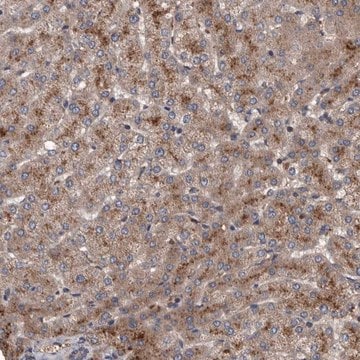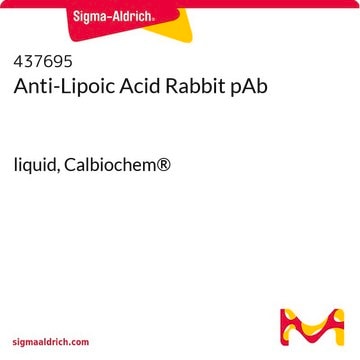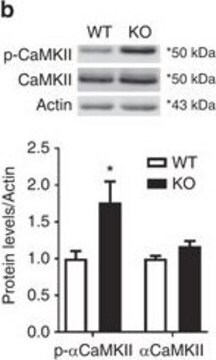ABT1346
Anti-Bikunin (CP6)
serum, from rabbit
Synonym(e):
Protein AMBP, alpha-1-microglobulin/bikunin precursor, Inter-alpha-trypsin inhibitor light chain, ITI-LC, Bikunin, EDC1, HI-30, Uronic-acid-rich protein
About This Item
Empfohlene Produkte
Biologische Quelle
rabbit
Qualitätsniveau
Antikörperform
serum
Antikörper-Produkttyp
primary antibodies
Klon
polyclonal
Speziesreaktivität
human, mouse
Speziesreaktivität (Voraussage durch Homologie)
porcine (based on 100% sequence homology), camel (based on 100% sequence homology), nonhuman primates (based on 100% sequence homology), feline (based on 100% sequence homology)
Methode(n)
western blot: suitable
NCBI-Hinterlegungsnummer
UniProt-Hinterlegungsnummer
Versandbedingung
ambient
Posttranslationale Modifikation Target
unmodified
Angaben zum Gen
human ... AMBP(259)
Allgemeine Beschreibung
Spezifität
Immunogen
Anwendung
Zellstruktur
Western Blotting Analysis: A representative lot detected ~132 kDa Pre-IαI (PαI, bikunin·HC3) in murine airway epithelial cell (AEC) lysate (Abbadi, A., et al. (2015). J. Biol. Chem. 291(3):1448-1455).
Western Blotting Analysis: A representative lot detected ~37 kDa human urine bikunin, as well as the in vitro generated ~125 kDa PαI (bikunin·HC3) by TNF-stimulated gene 6-/TSG-6-catalyzed transfer of a single heavy chain (HC) from mouse serum to the glycosaminoglycan of bikunin using either human urine or purified human urine bikunin (Lamkin, E., et al. (2015). J. Biol. Chem. 290(8):5156-5166).
Immunohistochemistry Analysis: A representative lot localized bikunin immunoreactivity in 10% formalin-fixed (48 h), 5% EDTA-decalcified (14 days), paraffin-embedded human femoral condylar cartilage sections (Yoshihara, Y., et al. (2008). Osteoarthritis Cartilage. 16(11):1343-1355).
Qualität
Western Blotting Analysis: A 1:500 dilution of this antiserum detected bikunin immunoreactive bands (IαI & PαI) in 44.8 µg of mouse serum proteins.
Zielbeschreibung
Physikalische Form
Lagerung und Haltbarkeit
Handling Recommendations: Upon receipt and prior to removing the cap, centrifuge the vial and gently mix the solution. Aliquot into microcentrifuge tubes and store at -20°C. Avoid repeated freeze/thaw cycles, which may damage IgG and affect product performance.
Sonstige Hinweise
Haftungsausschluss
Not finding the right product?
Try our Produkt-Auswahlhilfe.
Lagerklassenschlüssel
12 - Non Combustible Liquids
WGK
WGK 1
Flammpunkt (°F)
Not applicable
Flammpunkt (°C)
Not applicable
Analysenzertifikate (COA)
Suchen Sie nach Analysenzertifikate (COA), indem Sie die Lot-/Chargennummer des Produkts eingeben. Lot- und Chargennummern sind auf dem Produktetikett hinter den Wörtern ‘Lot’ oder ‘Batch’ (Lot oder Charge) zu finden.
Besitzen Sie dieses Produkt bereits?
In der Dokumentenbibliothek finden Sie die Dokumentation zu den Produkten, die Sie kürzlich erworben haben.
Unser Team von Wissenschaftlern verfügt über Erfahrung in allen Forschungsbereichen einschließlich Life Science, Materialwissenschaften, chemischer Synthese, Chromatographie, Analytik und vielen mehr..
Setzen Sie sich mit dem technischen Dienst in Verbindung.








